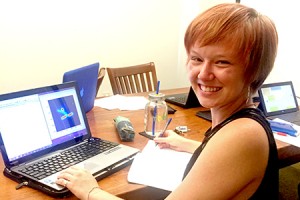Celina Bekins is a sophomore at Franklin W. Olin College of Engineering, where she is studying Mechanical Engineering with concentrations in Robotics and Sustainability. She grew up on Maui and has had to adjust to not seeing the sun all the time in Massachusetts, but she is extremely excited to have an internship at home for the 2015 summer. She is also immensely happy to be working at the Air Force Research Laboratory at the Maui High Performance Computing Center in Kihei. She attended Kihei Charter’s STEM Academy Middle School for the first three years of its existence, where two of the classes were held at the MHPCC – you could say this internship is bringing her back to where her love for engineering began.
Project Title: WavePy: Creating a Python Package for Wave Optics Researchers
Host Organization: Air Force Research Laboratory at the Maui High Performance Computing Center
Mentors: Jeremy Bos and Michael Werth
Project Abstract:
United States Air Force researchers are constantly trying to enhance images collected by groundbased telescopes of objects in space. Countless computer simulations have been performed to simulate images that have been corrupted by atmospheric turbulence for the purposes of testing new enhancement algorithms. However, these simulations have mostly been done in MATLAB, a proprietary software package, which is expensive and slow to incorporate new technology. This project aimed to make those simulations easier to run and share by using Python, a frequently updated opensource language, instead. Pre-existing MATLAB simulation code was translated into Python and this translation was benchmarked against the original. These fully translated and benchmarked functions were put into a new Python package called WavePy, which can easily be used by any researcher who downloads and imports it, similar to other popular Python packages. The benchmarking performed thus far shows the new Python code is as effective as the MATLAB code, running intensive algorithms in comparable amounts of time and producing the same results. Using WavePy, researchers will have a variety of wave optics functions readily available, rather than having to design and code entire simulations whenever they want to further their research. Moving forward, optimization might make WavePy’s code run even faster and thereby more efficiently than the MATLAB code.
